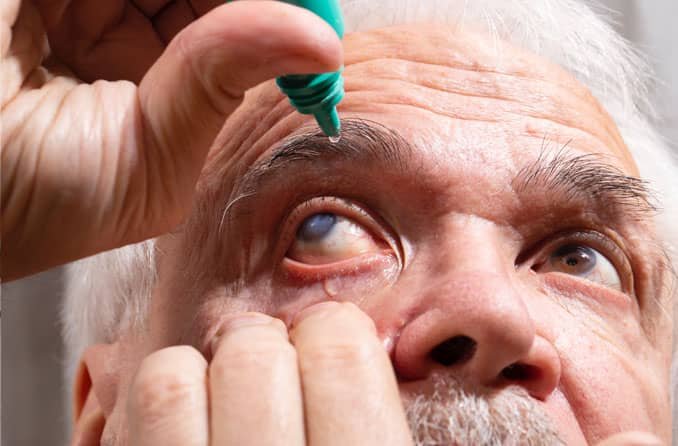
Cataract: Types, Symptoms and Treatments
A cataract is a clouding of the lens of the eye. It is the most common cause of vision loss in people over 40 and the leading cause of blindness in the world. Types of cataracts:
- A subcapsular cataract develops in the back of the lens. People with diabetes or those taking high doses of steroids have an increased risk of developing subcapsular cataracts.
- Nuclear cataracts form deep in the central zone (nucleus) of the lens. Typically, nuclear cataracts are associated with aging.
- A cortical cataract is characterized by white, wedge-shaped opacities that first form
at the periphery of the lens, and then spread to the center in the form of spoke-like zones.
This type of cataract is localized in the lens cortex, which is the part of the lens
surrounding the central nucleus.
Symptoms and signs of cataracts
In the early stages of development, cataracts have little effect on your vision. You may notice that your vision is a little blurry as if you are looking through foggy glass or viewing Impressionist paintings.
“Fog” in the eyes and lack of clarity of vision can be a symptom of cataracts.
With cataracts, the light from the sun or a lamp may appear too bright or blinding. You may notice that when you are driving at night, the oncoming headlights are causing more glare than before. Colors may not look as vibrant as they used to.
What type of cataract you have will affect exactly what symptoms you experience and how soon they appear. When a nuclear cataract develops first, it can lead to a temporary improvement in your near vision, called “second vision.”
Unfortunately, this improvement in vision is short-lived and will disappear as the cataract progresses. On the other hand, a subcapsular cataract may not cause any symptoms until it is fully developed.
If you think you have a cataract, see your optometrist for an examination to find out exactly.
What Causes Cataracts?
The lens inside the eye works like a camera lens, focusing light on the retina for clear vision. It also adjusts the focus of the eye, allowing us to see objects both close and far.
The lens is mainly composed of water and protein.
The protein is positioned in a strictly defined way so that the lens remains
transparent and allows light to pass through.
But as we age, some of the protein can lose its structure and form clusters, starting to cloud a small area of the lens. This is a cataract, and it can get larger over time, leading to a clouding of the lens, making it harder to see.
No one knows for sure why the lens of the eye changes with age, forming a cataract. But researchers around the world have identified factors that can cause cataracts
In addition to age, risk factors for developing cataracts include:
- Ultraviolet radiation
- Diabetes
- Hypertension
- Obesity
- Smoking
- Long-term use of corticosteroid drugs
- Statin drugs used to lower cholesterol
- Previous eye injury or inflammation
- Previous eye surgery
- Hormone replacement therapy
- Significant alcohol consumption
- High myopia (nearsightedness)
- Family history
One theory of cataract formation is that many cataracts are caused by oxidative
changes in the lens of the human eye. This assumption is supported
by nutritional studies that show fruits and vegetables are high in antioxidants
that help prevent certain types of cataracts.
Prevention of cataracts
While there is considerable controversy over whether cataracts can be prevented,
a number of studies show that certain nutrients
and dietary supplements can reduce the risk of developing cataracts.
One 10-year study in medical women showed that increased intake of vitamin E,
the carotenoid lutein, and zeaxanthin with food and nutritional supplements are associated
with a significantly reduced risk of developing cataracts.
Good dietary sources of vitamin E include sunflower seeds, almonds, and spinach. Good sources of lutein and zeaxanthin include spinach, kale, and other green leafy vegetables.
Other studies have shown that antioxidant vitamins, such as vitamin C and foods containing omega-3 fatty acids, can reduce the risk of cataracts.
Another measure you can take to reduce your risk of cataracts is to wear sunglasses that block 100 percent of the sun’s UV rays when you are outdoors.
Cataract treatment
When symptoms start to appear, you can improve your vision for a while by using new glasses, strong bifocals,, magnifying devices, appropriate lighting, and other means to improve vision.
When the cataract is sufficiently advanced to the point that it has a significant
impact on visual acuity and quality and on your daily life, consider surgical treatment.
Many people perceive poor vision as an inevitable fact of aging, but cataract surgery is a simple and relatively painless procedure to restore vision.
During surgery, the surgeon will remove the cloudy lens and, in most cases, replace it with a clear plastic intraocular lens (IOL).
New IOLs are being developed that make surgery easier for surgeons
and provide greater benefit to patients. IOL to correct presbyopia potentially help you see at all distances, not just one. Another new type of IOL blocks both ultraviolet radiation and high-energy visible blue light, which research has shown can damage the retina.
Spectacle optics after cataract surgery
In most cases, with the exception of presbyopia correction IOLs, you will need reading glasses after cataract surgery. You may also need progressive lenses to correct small residual refractive errors as well as presbyopia.
For the best vision and comfort when wearing glasses prescribed after cataract surgery, ask your optometrist to explain the benefits of anti-reflective coating. and photochromic lenses.
Read more health articles




Зарегистрируйтесь прямо сейчас и получите 100 фриспинов без депозита, чтобы испытать свою удачу в увлекательных играх и повысить свои шансы на крупный выигрыш. рейтинг казино онлайн aggqlrwhye …